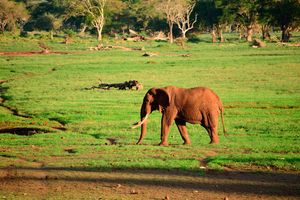Alarm over severe decline of elephant populations due to habitat loss and poaching

A herd of elephants at the Maasai Mara National Reserve.
What you need to know:
- The report underscores that the crisis is primarily driven by habitat loss and poaching, threatening the existence of the animals.
Africa’s elephant population is facing an alarming decline, with new research revealing a staggering drop in Forest and Savanna elephants over the past five decades.
Save the Elephants and Wildlife Conservation Society researchers unveiled one of the most detailed studies on the status of the two African elephant species using data on population surveys conducted at 475 sites in 37 countries from 1964 through 2016.
In the study published by the Proceedings of the National Academy of Sciences, the researchers focused on the population dynamics of elephants in their natural habitats.
Among the key findings, the Savanna elephant populations fell by about 70 per cent on average at the surveyed sites while the Forest populations dropped by a staggering 90 per cent on average.
Researchers further revealed that on average, there was a 77 per cent population decrease at the various surveyed sites across both species in the continent.
The report underscores that the crisis is primarily driven by habitat loss and poaching, threatening the existence of the animals.
According to the new research, the population trends varied significantly as some elephant populations have reportedly disappeared entirely, with others showing rapid growth.
Become extinct
For instance, Southern Africa saw a 42 per cent average increase in Savanna elephant populations, with only 10 per cent of surveyed populations in Eastern Africa increasing.
However, no elephant populations in the Northern Savannas grew, and many became extinct.
"While the overall picture is discouraging for both species, we see that some populations remain stable or are even growing," said Boo Maisels, a conservation scientist at Wildlife Conservation Society and a contributing author of the study.
George Wittemyer, the senior author and elephant expert with Save the Elephants, said the study helped pinpoint regions where the population of the jumbos increased, and successful conservation efforts.
"This study helps us pinpoint successful conservation actions in different contexts. We must develop and implement a portfolio of effective solutions to address the diverse challenges elephants face across Africa," Wittemyer said.
Examples of Forest elephants include those of Nouabale-Ndoki National Park in Democratic Republic of Congo and Mbam et Djerem National Park in Cameroon; and for Savanna elephants, Katavi-Rukwa and Ruaha-Rungwa ecosystems in Tanzania and KAZA landscape in Southern Africa.
Study results show that if well protected and managed, elephant populations can still increase despite increasing pressures surrounding them and their habitats.
The new research further provides crucial insights into elephant conservation status in Africa, highlighting areas of concern and opportunities for learning from success stories in regions or sites where populations remain stable or increasing.
Researchers believe that as threats to elephants continue to mount, their comprehensive analysis offers valuable direction for future conservation efforts.
In Kenya, for instance, three iconic elephants that were popularly known among conservationists and tourists have been previously killed.
Edison, Sarara and Yeagar died prematurely as a result of a tragic outcome of the rising cases of human-elephant conflict in Kenya and other parts of Africa.
Sarara was a majestic bull and one of the most beloved and famous resident bull elephants in Samburu National Reserve.
Researchers recently found out that beehive fences may hold the key to peaceful coexistence between humans and elephants in Kenya.
The study published in the journal Conservation Science and Practice revealed that the installation of beehives with live honey bees on fences around smallholder farms in the country repelled elephants by more than 86 per cent during peak crop season.
These fences, which use bees' natural behaviour to keep elephants at bay, have suggested to be highly effective in helping to reduce human-elephant conflict for local farmers in the country.
This finding offers a promising alternative for farmers who have struggled to protect their crops from elephant herds without resorting to harmful or lethal methods.
Conflicts between elephants and local communities have escalated in several parts of the country and are often fueled by shrinking habitats, poaching, climatic change and encroachment on migratory routes.
The nine-year study was conducted by scientists from the Kenya Wildlife Service and researchers from Save the Elephants, a research and conservation organisation, the Wildlife Research and Training Institute of Kenya and Oxford University.





